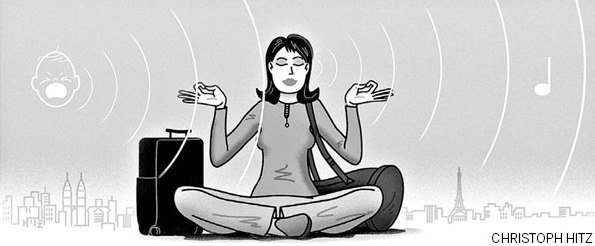Finding peace amid noise of travel

On one April Fools' Day, the Canadian airline WestJet joked that it was creating child-free cabins by putting kids in a "special V.I.P." area of the plane. An accompanying video showed children scooting along a luggage belt and being stored in a plane's cargo hold.
There has been a lot of clamor over children's areas, real and imaginary, but there is a deeper story here. It's about silence, and how different cultures value or don't value it - a nuance that becomes obvious when we travel.
Music blaring from headphones, booming cellphone conversations and garrulous passengers are as much a part of travel as removing your shoes at the airport. And the din has plenty of people "annoyed, stressed, oppressed," said Mike Goldsmith, the former head of the acoustics group at the National Physical Laboratory in England and author of "Discord: The Story of Noise."
"The hearing system evolved in part as a warning system, so there is a natural tendency to classify noise as threat," he said. "But, more importantly, noise is an intrusion, a challenge to our rights over our immediate environment."
In the travel milieu, noise has become so commonplace that it's increasingly being managed with rules, like cellphone bans on buses and quiet cars on trains. But some survival strategies - noise-canceling headphones, nasty looks and sleeping pills (not necessarily in that order) - may make you feel antisocial or, worse, mean.
"Denial of what's going on just doesn't work," said Andy Puddicombe, a former monk who discusses the benefits of meditation in his book "Get Some Headspace" and on his Web site, Headspace.
Attempting to ignore the loudmouth next to you by breathing deeply is what Mr. Puddicombe calls a classic meditation-related mistake - and one that's likely to frustrate you even more as you struggle to focus on your breath.
There's not much you can do about a plane or train buzzing with sounds. What you can change, of course, is how you respond.
"The sound - that in itself isn't the problem," Mr. Puddicombe said. "The problem is the resistance in our mind."
In other words, don't fume about shouting children and ineffectual parents. Mr. Puddicombe said your discomfort is the gap between reality (the noisy child) and what you want the situation to be (quiet). What Mr. Puddicombe calls "mindfulness meditation" (essentially being in the present moment) can help bridge the space between reality and desire.
"It's letting go of what we want it to be," he said, "and moving closer to acceptance of what is happening right now." (Hint: this can also be applied to matters of work, health, love.)
How wonderfully sane. But how to do it?
First, simply acknowledge that you're frustrated (in your head, not by lobbing a shoe). "When you look at resistance it starts to lose its intensity," Mr. Puddicombe said. Then, listen to the sound. Don't blame the noisemakers. Just listen to the sound. "If you give that your full attention," Mr. Puddicombe said, "eventually the mind will get bored of it."
He gave as an example being on an hourlong train ride next to someone with iPod music loud enough for you to hear. Your mind simply won't stay focused on the music for an hour, Mr. Puddicombe said.
When listening to a noise, aim for "gentle acceptance."
Don't worry about deep breathing. "Let go of the breath," Mr. Puddicombe said. "We're not talking about some sort of escapist trick of the mind."
But beyond the theory of acceptance, there are physiological reasons to keep noise to a minimum. "Noise goes up, heart rate goes up," said Julian Treasure, chairman of the Sound Agency, which advises businesses on how to use sound. "That is not good for you."
He was referring to teachers who have to shout to be heard in their classrooms. But the idea that noise can raise heart rates likely comes as no surprise to, say, frequent business travelers who can feel the tension rising in their bodies during rowdy flights.
If you find yourself on a noisy plane, it may be calming to remember that if you have an expectation of silence it's because you consider it to be a social norm. Not everyone has the same social norms, though. Nor should they.
"The culture is changing on the airplane from a very polite space to one that's much more culturally diverse," said Setha Low, a professor of anthropology and psychology and the director of the Public Space Research Group at the Graduate Center, City University of New York. "And there's a lot of difference between the norms."
Those differences can lead to conflicts, especially on planes where people from all over the globe converge. Some cultures, like Spain's, for example, are more gregarious than others, like Scandinavia's.
One method of dealing with these sorts of conflicts has been to create separate and pricier transportation alternatives. But that can feel exclusionary.
"More and more people are trying to make sanitized public space, and the question is where is this going to lead us?" Professor Low said.
We don't yet know. For now, press play on the Headspace app to hear Mr. Puddicombe's voice. "So there might be sounds in the room where you are," he says, "in the next room, or even outside of the building."
Take 10 seconds or so, "just to allow those sounds to come and go, in and out of your awareness," he says.
Set aside a few minutes each day to let Mr. Puddicombe whisper in your ear with the hope that on your next flight, you will be able to lean back, sip a club soda and gently accept whatever racket may come.
The New York Times


















